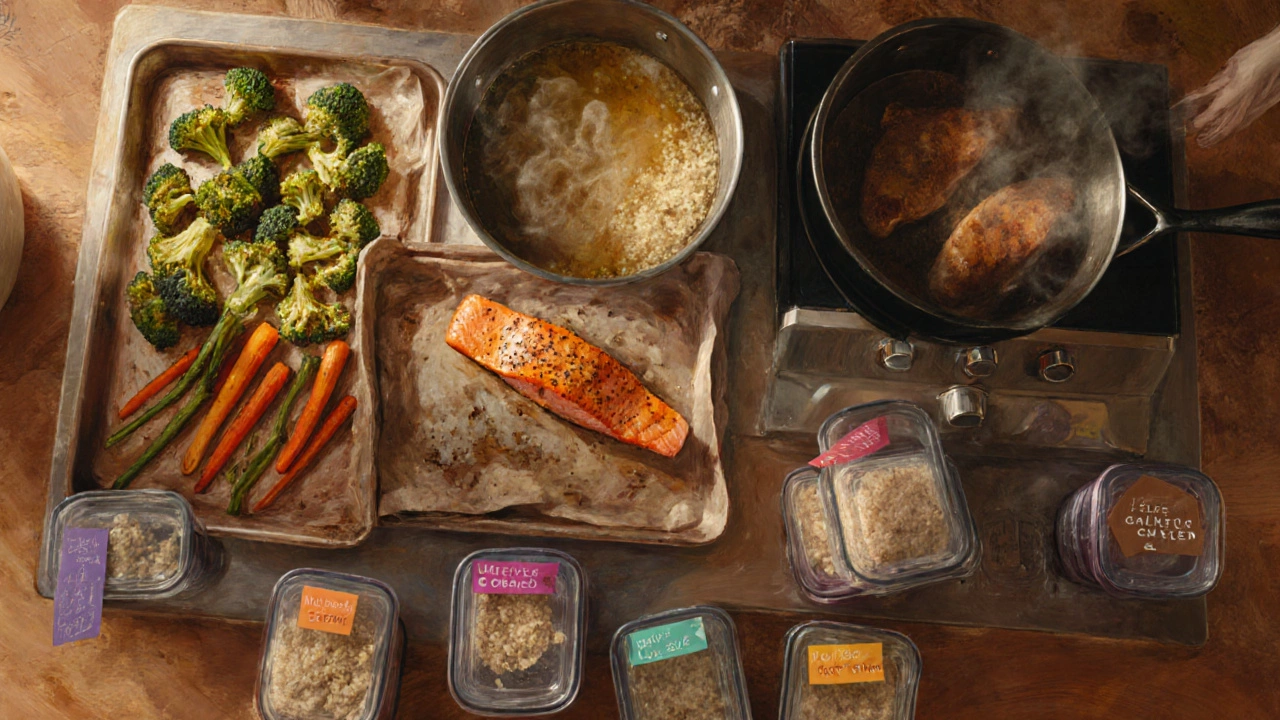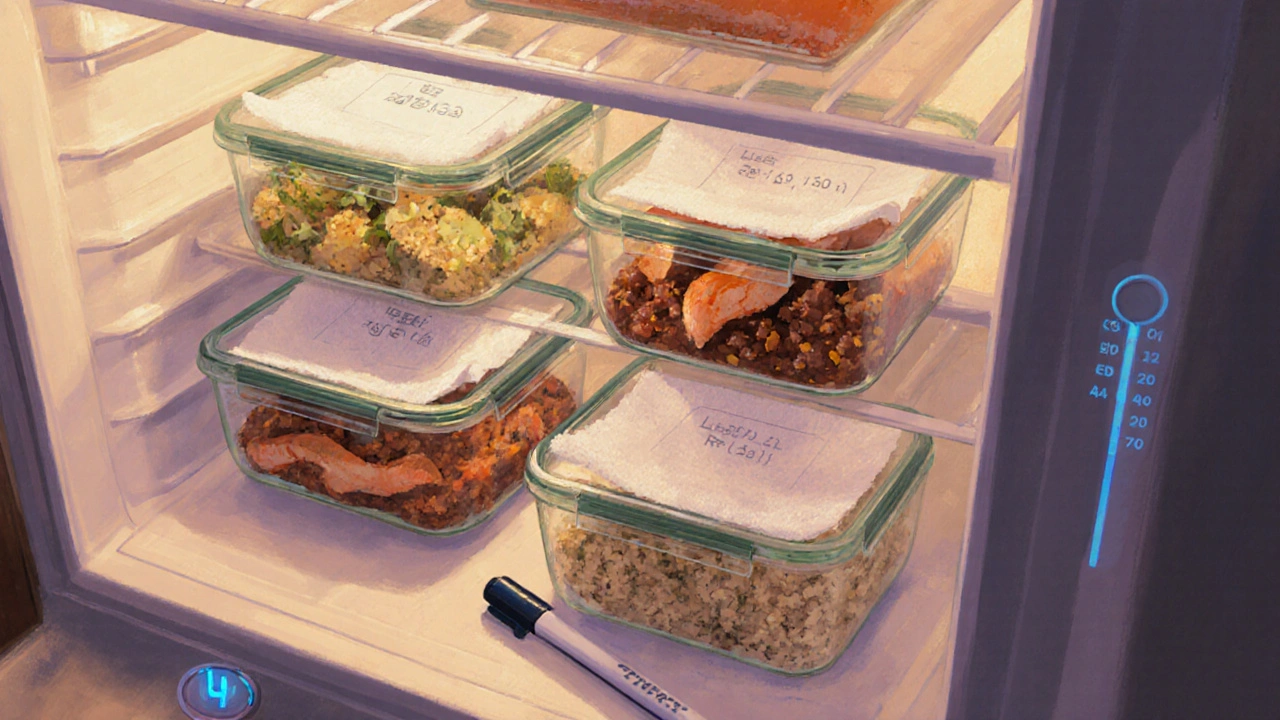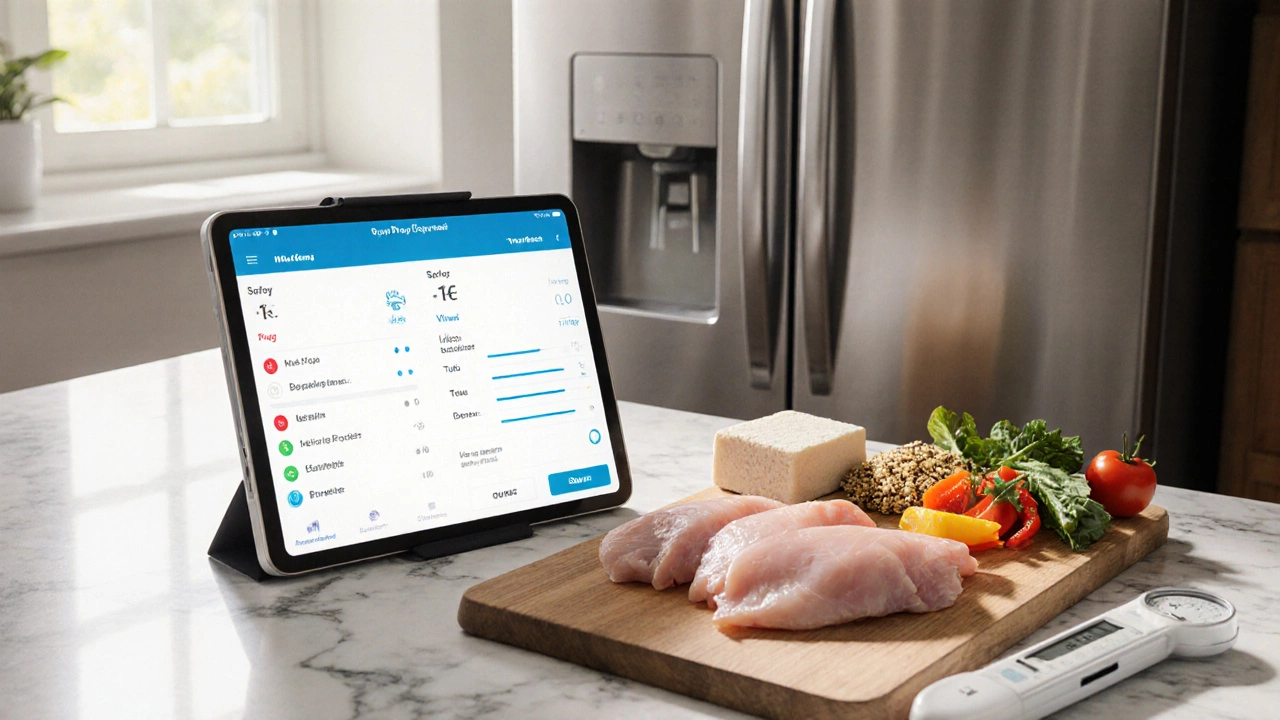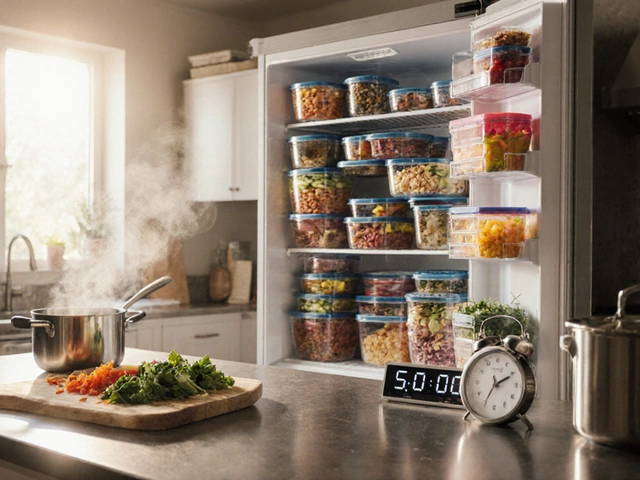5-Day Meal Prep Safety Checker
Enter your details and click "Check Meal Prep Safety" to evaluate if your meal prep plan meets 5-day safety standards.
Quick Takeaways
- Five‑day meal prep is safe if you chill foods within two hours and keep the fridge at 4°C (39°F) or below.
- Plan meals around proteins, carbs, and veggies that stay fresh for a full workweek.
- Use airtight, portion‑sized containers and label them with the date you cooked.
- Reheat to at least 74°C (165°F) to kill any lingering bacteria.
- Rotate leftovers - eat the oldest meals first to avoid waste.
When you hear the question, meal prep for 5 days, most people picture a single Sunday marathon of cooking, then shoving everything into the fridge. That sounds doable, but is it actually safe and practical? Below you’ll find a step‑by‑step guide that covers the science of food safety, smart menu planning, cooking shortcuts, storage tricks, and reheating rules. Follow the plan and you’ll end the week with a fridge full of tasty, nutritious meals - no nasty stomach bugs required.
Understanding Food Safety for a 5‑Day Batch
Food Safety is the set of practices that keep cooked food from becoming a breeding ground for harmful bacteria. The two biggest enemies are Clostridium perfringens and Staphylococcus aureus, which multiply quickly when food sits in the “danger zone” (5°C‑60°C or 41°F‑140°F). The rule of thumb is the 2‑hour rule: get food from the pot to the fridge within two hours of finishing cooking.
To make sure the fridge does its job, maintain a temperature of 4°C (39°F) or lower. A cheap fridge thermometer can save you from a costly mistake. If you live in Melbourne’s summer heat, consider a freezer‑grade bag for the hottest days - it adds an extra safety buffer.

Planning Your 5‑Day Menu
Good planning prevents waste, saves money, and ensures you hit your nutrient goals. Start with three pillars:
- Portion Size - Aim for 350‑450g per meal, split into 150g protein, 150g carbs, and 150g veggies.
- Nutrient Balance - Include a source of lean protein, complex carbohydrate, and at least two different coloured vegetables.
- Shelf Life - Choose foods that stay fresh for five days: chicken breast, firm tofu, quinoa, sweet potatoes, broccoli, carrots, and canned beans.
Here’s a quick example of a balanced weekly menu:
- Monday/Tuesday - Lemon‑herb chicken, quinoa, roasted broccoli.
- Wednesday/Thursday - Beef & sweet‑potato chili, brown rice, mixed greens.
- Friday - Mediterranean salmon, couscous, sautéed zucchini.
This layout gives you only three different main dishes, reducing cooking time while still offering variety.
Cooking and Batch Techniques
Batch cooking is all about efficiency. Use the same pan or sheet tray for multiple ingredients to cut down on cleanup. Invest in a set of reliable Kitchen Tools - a large stockpot, a sheet‑pan, a food processor, and a good set of knives. The food processor helps you shred carrots or slice zucchini in seconds, which keeps the cooking process under the two‑hour window.
Follow this simplified workflow:
- Pre‑heat the oven to 200°C (390°F). While it heats, start boiling water for grains.
- Season and sear all proteins on the stovetop (about 5‑7minutes total). Transfer to the oven to finish cooking while you roast veggies on a second sheet‑pan.
- Cook grains (quinoa, rice, couscous) simultaneously on the stovetop - each takes 12‑20minutes.
- As soon as each component reaches its safe internal temperature (74°C for meat, 70°C for tofu), let it rest for a couple of minutes, then portion out.
By overlapping tasks, the total active cooking time stays under 90minutes, giving you plenty of headroom for the cooling rule.
Storing Meals Properly
The moment you finish cooking, the Refrigeration step becomes critical. Follow these guidelines:
- Cool food quickly by spreading it in a shallow layer (no thicker than 5cm) on a clean tray.
- Transfer to Meal Prep Containers that are BPA‑free, leak‑proof, and have a snap‑on lid. Glass containers with a silicone seal work great.
- Label each container with the prep date using a waterproof marker.
- Store raw proteins on the bottom shelf to avoid cross‑contamination.
Here’s a quick reference for how long common foods stay safe in the fridge (all at 4°C):
| Food Item | Maximum Freshness (Days) | Recommended Storage |
|---|---|---|
| Cooked chicken breast | 4 | Airtight container, front shelf |
| Ground beef (cooked) | 3 | Bottom shelf, sealed |
| Quinoa / brown rice | 5 | Cool, sealed container |
| Roasted vegetables | 5 | Vent‑locked container |
| Salmon (cooked) | 3 | Bottom shelf, glass container |
| Fresh salsa / tomato‑based sauces | 4 | Glass jar, tight seal |
If you need an extra day of safety, shift the container to the freezer (up to 2months) and thaw on the night before you plan to eat it.

Reheating and Eating Safely
Microwaves are convenient, but they can leave cold spots. A simple rule: reheat until the interior reaches 74°C (165°F). Use a food thermometer for the first few meals; after that you’ll develop a feel for the right steam.
Best reheating methods per container type:
- Glass containers - Microwave 2‑3 minutes, stir halfway.
- Plastic BPA‑free containers - Microwave on medium power, cover with a vented lid.
- Metal‑free silicone bags - Submerge in a pot of simmering water for 5‑7 minutes.
Always give the meal a quick visual inspection - any off‑color, sour smell, or slimy texture means it’s time to toss it.
Common Pitfalls & Pro Tips
Even seasoned preppers slip up. Here are the most frequent mistakes and how to avoid them:
- Over‑cooking proteins. They become dry after reheating. Use a meat thermometer to stop cooking at 72°C, then finish in the fridge.
- Using the wrong containers. Thin plastic can warp, leaking broth into your fridge. Invest in sturdy glass or thick‑walled BPA‑free plastic.
- Stacking hot containers directly in the fridge. This raises the overall temperature. Let food cool on the counter first, then use a cooling rack.
- Skipping the label. Without a date, you’ll lose track and may eat past the safe window. A quick scribble does the trick.
- Not rotating meals. Eat the oldest meal first. Arrange containers by date on a shelf - front to back, oldest in front.
Pro tip: add a splash of fresh lemon juice or a drizzle of olive oil right before reheating. It revives flavors that dull after a few days.
Frequently Asked Questions
Is it safe to keep cooked chicken for five days?
Cooked chicken stays safe for up to four days in a properly chilled fridge (4°C). If you need a fifth day, freeze one of the portions and thaw it the night before you plan to eat it.
Can I use the same container for different meals?
Yes, as long as you clean it thoroughly between uses. Glass containers are easiest to sterilize: a quick wash in hot, soapy water or a 2‑minute run through the dishwasher does the job.
Do I need a separate fridge for meal prep?
Not necessarily, but a dedicated drawer or shelf helps you keep prepped meals organized and reduces the risk of cross‑contamination with raw foods.
What’s the best temperature for reheating?
Aim for an internal temperature of 74°C (165°F). Use a digital food thermometer for the first few meals; after that, look for steady steam and a hot center.
How can I keep vegetables from getting soggy?
Roast or steam them just until tender, then cool quickly on a wire rack. Store in a container with a paper towel to absorb excess moisture, or keep them separate from sauces until you’re ready to eat.
With the right planning, the two‑hour cooling rule, and sturdy containers, five‑day meal prep becomes a reliable way to eat healthily without spending a lot of time in the kitchen each day. Give it a try - you’ll be surprised how much smoother your weekdays can feel.





